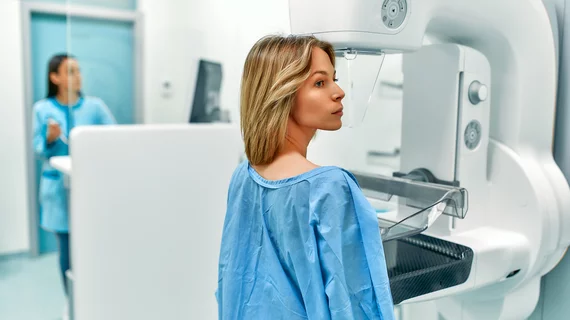The U.S. Preventive Services Task Force on Tuesday morning finalized new breast cancer screening recommendations, which the American College of Radiology said “do not go far enough.”
Like the USPSTF outlined last year, the guidelines now urge all women to begin undergoing mammography every other year starting at age 40. The influential organization had previously recommended women “make an individual decision” on when to begin screening prior to 50, but now is reversing course and matching other medical societies’ guidance.
ACR had hoped the task force would endorse annual mammograms beginning at 40, expressing disappointment about the decision Tuesday morning. The American Cancer Society, Society of Breast Imaging and others all agree that yearly imaging is the most effective approach, ACR said.
“The final United States Preventive Services Task Force breast cancer screening recommendations, while an improvement over previous guidance, do not go far enough to save more women’s lives,” ACR said in a statement shared April 30. “The ACR and SBI maintain their commitment to promote the value of annual screenings with mammography as stated in their joint average-risk guidelines. Medical experts must clear the confusion caused by differing recommendations,” the college added later.
USPSTF is recommending that screening continue through age 74. However, it believes more research is needed on whether additional exams might help those with dense breasts, along with the benefits and harms of screening beyond 75.
“More women in their 40s have been getting breast cancer, with rates increasing about 2% percent each year, so this recommendation will make a big difference for people across the country,” said task force Chair Wanda Nicholson, MD, MBA. “By starting to screen all women at age 40, we can save nearly 20% more lives from breast cancer overall.”
Black women are 40% more likely to die of breast cancer than their white counterparts, USPSTF noted. And “too often,” they develop deadly cancer at younger ages. The task force believes initiating screening at 40 “is an important first step” to addressing this disparity. But it is “urgently” calling for more research on how to close the outcomes gap.
“We need to know how best to address the health disparities related to breast cancer so all women can live longer and healthier lives,” task force Vice Chair John Wong, MD, said in a statement. “Clinicians must help reduce any barriers to patients getting the recommended screening, timely, equitable and appropriate follow-up, and effective treatment of breast cancer.”
Breast cancer is the second most common cancer killer in the U.S., with over 43,000 women dying from the disease last year. For its latest recommendations, the USPSTF commissioned a systematic review to evaluate the effectiveness of different mammography screening strategies. Biennial imaging for women 40 to 74 is labeled a B recommendation (A and B grade recommendations are services that the task force most highly recommends implementing for preventive care). Meanwhile, USPSTF believes evidence is “insufficient” to assess the benefits of screening mammography at 75 or older (an “I statement”). It also believes the evidence is insufficient to demonstrate the benefits of supplemental screening using ultrasound or MRI in women who have dense breasts and have received a negative screening mammogram (I statement). Nearly half of all women have dense breasts, USPSTF noted, which can increase their risk of cancer while also impacting the effectiveness of mammography.
The final recommendations apply to cisgender women and all other individuals assigned as female at birth. It includes women at average risk of breast cancer, along with those who have a family history or dense breast tissue. However, it does not apply to people who have a personal history of breast cancer, are at very high risk of developing the disease due to genetic markers, or who have had a lesion on previous biopsies.
ACR on Tuesday also highlighted screening challenges among the LGBTQ community. Involving factors such as sex assigned at birth, hormone use and surgical history place transgender persons at increased risk of breast cancer. Biological females transitioning to male who do not undergo mastectomy remain at their previous risk and should continue screening. And due to hormone use, biological males transitioning to female are also at increased risk compared to other men and should speak with their physician.
ACR and SBI recommend that women continue screening at age 75 and beyond, “unless severe comorbidities limit life expectancy.”
You can read more about the final recommendations in JAMA.

